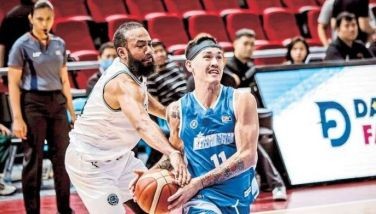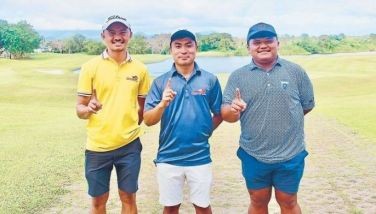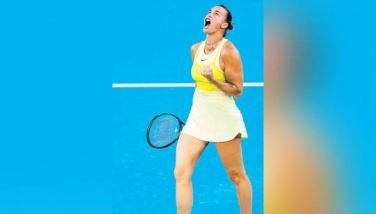Badion, basketball icon, passes away
June 22, 2002 | 12:00am
Carlos "Charlie" Badion, the sturdy youth from Tondo whose rugged ways have made him popular and controversial and earned him the monicker " "Bad Boy" of Philippine basketball, passed away late Thursday of heart attack. He was 66.
Badion, who donned the national colors in the 1956 Melbourne Games, the 1959 World championship in Chile and the 1960 Rome Olympics, was dead on arrival at the Mary Johnston’s Hospital where he was rushed after complaining of chest pain and difficulty in breathing.
The 5-foot-11 Badion has lost much of his bulk and weight which were his trademark in the glory years of his career due to poor health. He was particularly unstoppable with a unique offensive move known as the " bicycle drive".
Badion was a vital cog of the national team which finished seventh in a 15-nation cast in the Melbourne Games in 1956, playing alongside Carlos Loyzaga, Antonio Genato, Ramon Campos, Jr., Ramon Manulat, Martin Urra and Mariano Tolentino.
Then he became part of the starting unit of the national team which won the gold medal in the 1958 Asian Games in Tokyo and a mainstay of the team which won the inaugural staging of the Asian basketball championship in 1960 in Manila together with Loyzaga, Kurt Bachmann, Carbonell and Eduardo Lim. In fact, he was named to the all-star team with Loyzaga at the close of the tournament.
But Badion’s career was cut short when he injured a knee in the Philippines’ first round game against Uruguay in the 1960 Rome Olympics.
On the local turf, he was an original member of the Crispa team in the BAA and the multi-titled Yco in the Manila Industrial Commercial Athletic Association (MICAA) league.
Badion went into a number of business ventures upon retirement from basketball and was customs coordinator for Elizalde and Co. He began coaching in 1975, piloting Mapua to an NCAA championship and the UST women’s cage team to the UAAP title. He also handled the UST Glowing Goldies in the UAAP and the Army Jungle Fighters in the Philippine Basketball League.
He was also one of the Filipino athletes honored and given incentives by President Arroyo in elaborate rites two weeks ago. Badion’s rugged style and tough image had made him a controversial player and an enforcer in the late 1950s when Philippine basketball was in full bloom.
His body lies in state at the Funeraria Paz. He is survived by his wife Lolita and childrenHarry, Marivic and Carlo Darren. Interment is tentatively set Wednesday.
Badion, who donned the national colors in the 1956 Melbourne Games, the 1959 World championship in Chile and the 1960 Rome Olympics, was dead on arrival at the Mary Johnston’s Hospital where he was rushed after complaining of chest pain and difficulty in breathing.
The 5-foot-11 Badion has lost much of his bulk and weight which were his trademark in the glory years of his career due to poor health. He was particularly unstoppable with a unique offensive move known as the " bicycle drive".
Badion was a vital cog of the national team which finished seventh in a 15-nation cast in the Melbourne Games in 1956, playing alongside Carlos Loyzaga, Antonio Genato, Ramon Campos, Jr., Ramon Manulat, Martin Urra and Mariano Tolentino.
Then he became part of the starting unit of the national team which won the gold medal in the 1958 Asian Games in Tokyo and a mainstay of the team which won the inaugural staging of the Asian basketball championship in 1960 in Manila together with Loyzaga, Kurt Bachmann, Carbonell and Eduardo Lim. In fact, he was named to the all-star team with Loyzaga at the close of the tournament.
But Badion’s career was cut short when he injured a knee in the Philippines’ first round game against Uruguay in the 1960 Rome Olympics.
On the local turf, he was an original member of the Crispa team in the BAA and the multi-titled Yco in the Manila Industrial Commercial Athletic Association (MICAA) league.
Badion went into a number of business ventures upon retirement from basketball and was customs coordinator for Elizalde and Co. He began coaching in 1975, piloting Mapua to an NCAA championship and the UST women’s cage team to the UAAP title. He also handled the UST Glowing Goldies in the UAAP and the Army Jungle Fighters in the Philippine Basketball League.
He was also one of the Filipino athletes honored and given incentives by President Arroyo in elaborate rites two weeks ago. Badion’s rugged style and tough image had made him a controversial player and an enforcer in the late 1950s when Philippine basketball was in full bloom.
His body lies in state at the Funeraria Paz. He is survived by his wife Lolita and childrenHarry, Marivic and Carlo Darren. Interment is tentatively set Wednesday.
BrandSpace Articles
<
>
- Latest
- Trending
Trending
Latest
Trending
Latest
Recommended
January 18, 2025 - 12:00am





























